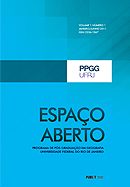Análise Crítica do Fator de Conversão van Bemmelen usado para Converter Dados de Matéria Orgânica de Solo em Dados de Carbono Orgânico: Análises Comparativas em um Solo Franco-Arenoso do Reino Unido
DOI:
https://doi.org/10.36403/espacoaberto.2016.5244Keywords:
Matéria Orgânica de Solo, Carbono Orgânico de Solo, Estação Experimental de Hilton, Fator de Conversão van Bemmelen.Abstract
Para conversão de dados de Matéria Orgânica de Solo (SOM) em dados de Carbono Orgânico de Solo (SOC) geralmente se usa o fator van Bemmelen de 0,58 (ou inverter a sua recíproca de 1.724) como fator de conversão universal. A precisão deste fator de
conversão tem sido questionada. Pelo Protocolo de Quioto (1997) a combustão seca é recomendada para fornecer análises que buscam medir estoques de carbono do solo. No entanto, equipamentos de combustão a seco são caros e exigem elevada manutenção. Para medições rápidas e de baixo custo é frequentemente utilizado a perda de peso por ignição (LOI). Um total de 278 amostras de solo franco-areno foram coletados entre 0-5 cm de profundidade em sessões de três solos em 09 de janeiro de 2007, 22 de janeiro de 2009 e 10 de outubro de 2011, a partir de parcelas de erosão em áreas gramadas de pastagens e parcelas em áreas cultivadas na estação experimental de Hilton, Shropshire, Reino Unido. Um total de 124 amostras de solo foram coletadas de parcelas de escoamento superficial e de splash nos anos de 2007 e 2009 (Bhattacharyya et al., 2011a). Cerca de 22 das amostras foram coletadas em 2011 nas áreas de pastagens (Horizonte Ah) e oito em solos cultivados (Horizonte Ap). As amostras de solo foram homogeneizadas e divididas para análise de SOM, que foi determinada em amostras secas ao forno, e análise de LOI e SOC total que foram determinadas por via seca. Um fator de conversão de 0,845 foi utilizada para se obter o SOC total de C, seguindo Rawlins et al. (2011). Os resultados mostraram fortes associações (R² = 0,70, p <0,001, n = 278) entre os dados da MOS e SOC. Para todos os dados, a SOM e os fatores de conversão SOC variaram entre 0,36-0,98, com um valor médio de 0,66 (DP = 0,105). Os valores médios do fator de conversão foram 0,64, 0,69 e 0,56, respectivamente, para as amostras coletadas em 2007, 2009 e 2011. Os resultados indicam que o fator de van Bemmelen (0,58) é um preditor razoável, mas ambas as variações temporais e espaciais ocorrem em torno de um tipo de solo específico. Assim, deve-se ter cuidado em conversões de dados SOM/SOC usando o fator van Bemmelen.



